When it comes to spotting Thailand’s wildlife, you don’t have to look very far. From urban areas to dense jungles, the country is teaming with unique creatures and creepy crawlies, including our 8-legged friend, the spider.
There are many common spiders in Thailand, and each species is vastly different from the other in terms of characteristics and danger-level.
Some you will encounter more than others, which is why we have prepared this guide to the most common spiders found in Thailand so you can be aware of them.
What Are The Most Common Species of Spider in Thailand?
1. Banded Phintella
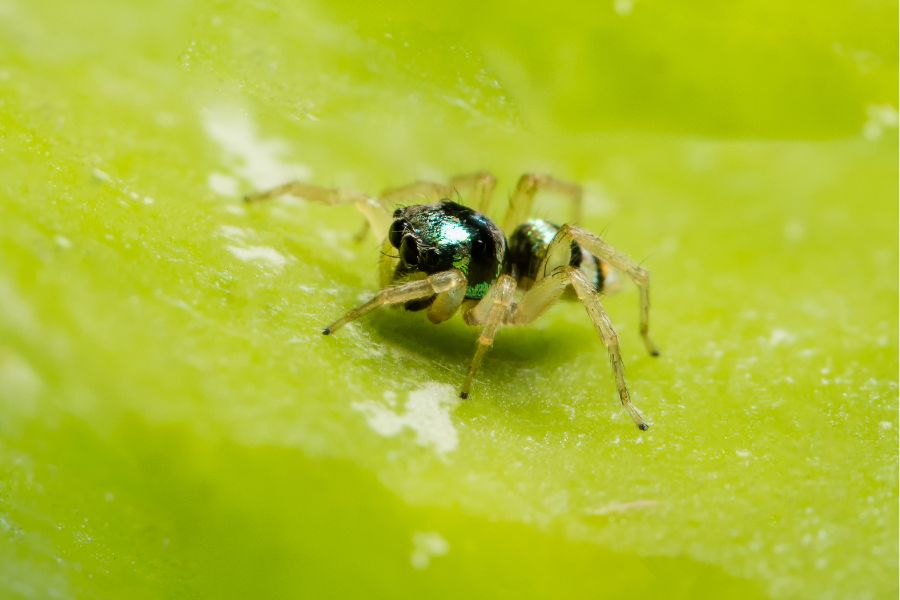
- Size: These are tiny spiders. Adult females typically measure around 4-5 mm in body length, while adult males are slightly smaller at 3-4 mm.
- Where in Thailand they can be found: These spiders are all over Thailand and are commonly found in lowland areas, including forests, gardens, and grassy areas. They are usually found in leaf litter and build small nests among vegetation.
- When are they most active? They are most active during the day, particularly in the morning and early afternoon. They can be found in sunny areas.
- Do they bite? While the Banded Phintella spider possesses venom, they are so tiny they are not considered venomous, or dangerous, to humans. Bites from these spiders are rare but they wouldn’t cause significant harm.
- What to do if you encounter one: If you encounter a Banded Phintella spider, it is best to observe it from a safe distance and avoid disturbing its habitat. These spiders are beneficial as they help control insect populations.
The Banded Phintella spider, scientifically known as Phintella vittata, is a species of jumping spider found in Thailand.
It has a distinctive black and white banded pattern on its abdomen. Its cephalothorax and legs are predominantly black, with hints of white markings.
The unique banded pattern on the abdomen of the Banded Phintella spider serves as a form of camouflage, blending in with the surrounding vegetation and making them less detectable to predators and prey.
This arachnid is an active hunter and doesn’t build a nest, but hunts on the forest floor. They rely on their incredible jumping ability to capture prey (usually small insects resting under leaves).
They have excellent eyesight and use it to locate and stalk their prey.
2. Black Widow & Brown Widow
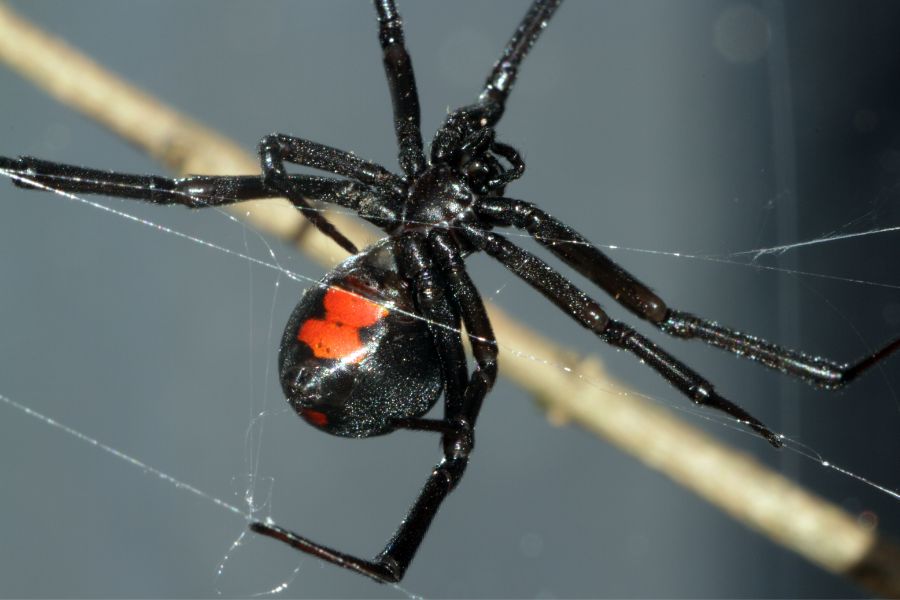
- Size: The average size of a Black Widow is from 3–10 mm, with some females measuring up to 13 mm in body length (not including legs). If you include the legs, an adult female can be as large as 25–38 mm
- Where in Thailand they can be found: They can be found all over Thailand, but are more prevalent in low-lying areas such as under BBQs, around rocks, wood piles, and swimming pools. They can be found in urban areas as well as rural areas.
- When are they most active? They are nocturnal animals and are usually more active at night.
- Do they bite? Yes, they can bite if they feel their webs have been disturbed. The bite of a Black Widow is usually a mild pain that increases gradually, and can last up to a week. It can also cause reactions such as fever, vomiting and headache.
- What to do if you encounter one: the best course of action is to keep your distance and avoid provoking or touching it. It’s important to respect their space and let them go about their spider business.
Black Widows are one of the most feared spiders in the world and are more commonly associated with Australia and Southern States of North America, however, they are a species that can be found all over the world.
Their numbers in Thailand are not known, but they are considered to be quite common, along with their brother species, Brown Widows. The Black Widow is slightly more venomous than the Brown Widow, but their characteristics and habitat are the same.
The female Black Widows are the most dangerous. They are characterised by their shiny black bodies with a red-orange hourglass print on their abdomen. Male Black Widows are brown, not black, with small red spots.
They are particularly active during warm months, so watch out for the dry seasons from March to May before the rain storms come.
ASEAN warns that Black Widows and Brown Widows are more prevalent during the rainy season in Thailand, another good reason why the rainy season is a bad time to visit Thailand.
They are one of the most dangerous animals in Thailand are not to be disturbed if you encounter one.
3. Black Tarantula
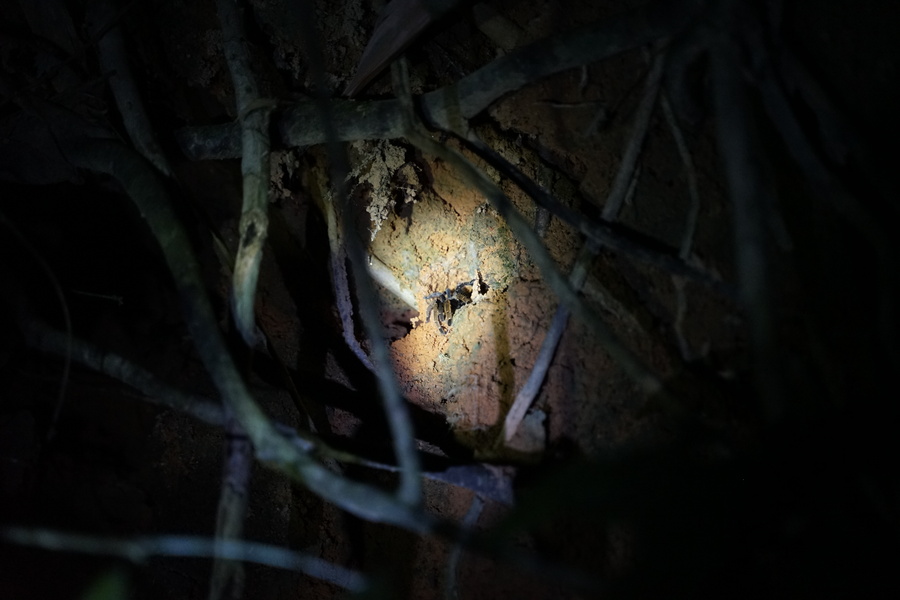
- Size: These creatures can measure up to 15 cm (6 inches), including legs. They are giant spiders that can weigh a whopping 42 g. Typically, males are smaller than females.
- Where in Thailand they can be found: They are usually found in jungle settings, for example, Koh Sok National Park. They prefer to hide in holes, or burrows, in the ground or in crevices in trees. They are usually found low to the ground.
- When are they most active? They are nocturnal creatures and mainly active at night.
- Do they bite? Black Tarantulas are generally docile spiders and will only bite if provoked. Their bites can be painful but are not considered dangerous to humans unless they are allergic.
- What to do if you encounter one: It is advisable not to provoke or handle them but observe them from a distance.
Possibly the largest spider species in Thailand is the Black Tarantula, known for their hairy bodies.
The Black Tarantula is described as having a black or dark brown body that is covered in dense hair. Typically, their body hair changes to a brown color when they are molting, which is usual for most tarantula species.
These spiders are not in large numbers in Thailand and typically don’t come into urban areas or contact with humans. They are venomous, but won’t bite unless they feel they are in danger.
4. Brown Recluse Spider

- Size: Adult Brown Recluse Spiders typically measure between 6mm and 20 mm on average, but can be larger.
- Where in Thailand they can be found: They can be found all over Thailand, but prefer dark, secluded areas such as attics, basements, closets, and woodpiles. They can also be found in undisturbed areas under rocks, boards, and the bark of dead trees.
- When are they most active? They are nocturnal hunters and feed on insects they come across while hunting at night. They are also most active during warm months and become less active during colder seasons.
- Do they bite? Yes, if you disturb its home, the Brown Recluse Spider will bite you. Their bites can be medically significant to humans and can cause pain, redness, and necrotic skin lesions and poisoning in some cases. It is important to note that bites are rare, and a bite is almost never fatal.
- What to do if you encounter one: You should avoid disturbing them, especially if they are their nest/web. This will lower the risk of them biting you. If you suspect a bite from a Brown Recluse Spider, seek medical attention promptly.
The Brown Recluse Spider, scientifically known as Loxosceles reclusa, is a venomous spider species that is the second most dangerous spider in Thailand after the Black Widow.
These spiders have a light brown body with a distinctive violin-shaped mark on their cephalothorax, which gives them the nickname “violin spider” or “fiddleback spider.”
As the name suggests, these spiders are reclusive and tend to hide during the day.
The Brown Recluse Spider is not native to Thailand, but it’s believed they came to the country after Japanese soldiers occupied Thailand during WWII.
5. Burmese Lynx Spider

- Size: The Burmese Lynx Spider typically measures between 4-16 mm in length. Typically, the male is slightly smaller than females.
- Where in Thailand they can be found: Burmese Lynx Spiders can be found in gardens, secondary forests, and low shrubs. They prefer habitats with vegetation where they can actively pursue their prey.
- When are they most active? They are most active during the day when they do their hunting. Burmese Lynx Spiders are agile hunters, running and jumping after their prey.
- Do they bite? While Burmese Lynx Spiders possess venom, they are not considered harmful to humans. They prefer to spit venom at their prey, as opposed to bite them. Bites are rare, and their venom is not potent enough to cause significant harm to humans.
- What to do if you encounter one: If you encounter a Burmese Lynx Spider, it is best to observe it from a distance and avoid disturbing its habitat. Appreciate their role in natural pest control.
The Burmese Lynx Spider, scientifically known as Oxyopes birmanicus, is a species of lynx spider found in various regions of Thailand.
These spiders have a distinctive pattern on their back and dark, spiky-looking legs.
Their agile hunting behavior during the day also sets them apart and they have excellent eye sight. They feed on other small insects and use the sunlight to aid their hunting.
They are a common spider found in Thailand and one that you would most likely encounter, if you were to encounter any.
They don’t build webs, but use the floor as their hunting ground, similar to Jumping Spiders. They are not usually bothered by humans and don’t mind you getting up close and personal to take a photo, but it’s best not to touch them or disturb them in any way.
6. Fighting Spider / Metallic Blue Jumping Spider
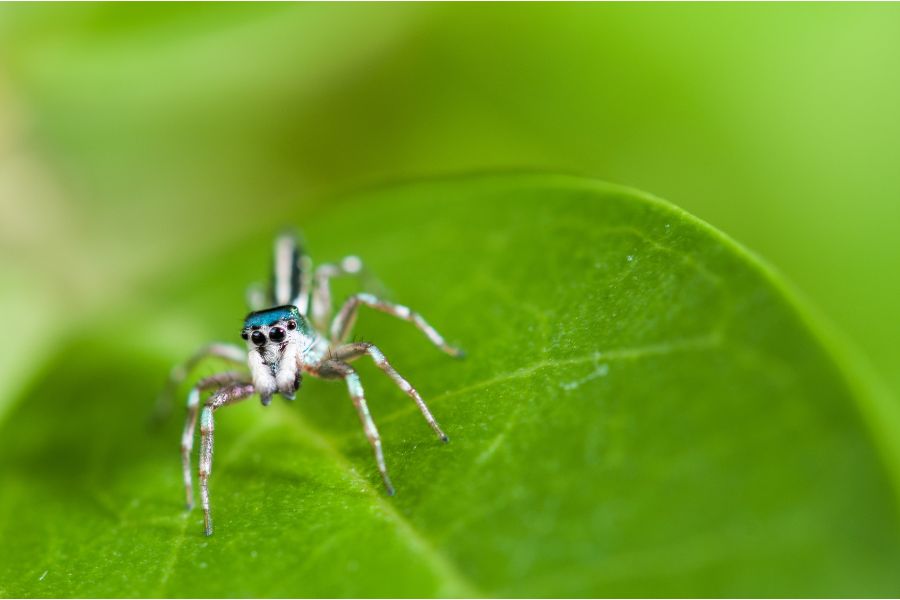
- Size: The average size of a Fighting Spider is 9mm – 10mm.
- Where in Thailand they can be found: Fighting Spiders can be found in various habitats in Thailand, including fruit gardens, forests, and urban areas.
- When are they most active? They are most active during the warmer months of the year, from spring to summer.
- Do they bite? While Fighting Spiders possess toxins, their bites are not considered medically significant to humans. Bites are rare and typically do not cause severe symptoms.
- What to do if you encounter one: If you encounter a Fighting Spider, it is best to observe it from a safe distance and avoid disturbing its habitat.
The Fighting Spider, scientifically known as Thiania bhamoensis, and also commonly referred to as the Metallic Blue Jumping Spider, is a species of jumping spider found in Thailand.
It has an iridescent green-blue coloration, with the females leaning more towards green and the males more towards blue. They have a compact and agile body structure.
Male Fighting Spiders are known for their aggressive behavior towards each other, hence their name. They engage in wrestling matches that involve pushing the other to establish dominance and territory.
They are also unique in that they build nests by binding a pair of leaves together, and then lay their eggs inside.
The Fighting Spider is relatively common in Thailand, particularly in Bangkok and other urban areas, though are thought to have originated from Burma. The name “bhamo” translates to “from Burma”.
7. Giant Golden Orbweaver
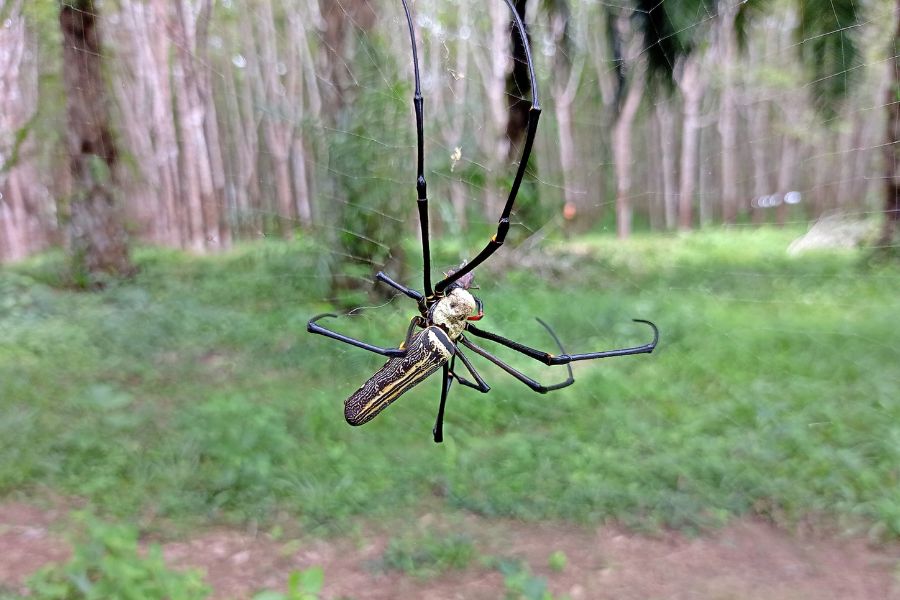
- Size: The females of the species are significantly larger than males. On average, they measure between 4.8 cm – 5.1 cm for females, and less than 2.5 cm for males
- Where in Thailand they can be found: These spiders can be found in forested areas, including rainforests and national parks, such as Khao Sok National Park, Nakhon Si Thammarat, and Chiang Dao. They also come into buildings and urban areas due to the large number of insects for them to eat.
- When are they most active? They are most active during warmer months when insect activity is high. They tend to retreat to sheltered locations during colder seasons. They are most active at night.
- Do they bite? While Giant Golden Orbweavers possess venom, their bites are generally not harmful to humans. Bites are rare, and the venom is not considered medically significant. You may experience mild pain, numbness and swelling, if bitten.
- What to do if you encounter one: If you encounter a Giant Golden Orbweaver, it is best to admire it from a safe distance without disturbing its web. Avoid touching or provoking it.
The Giant Golden Orbweaver, scientifically known as Nephila pilipes, is a species of golden orb-web spider found in Thailand.
They have a distinct golden coloration, with females displaying a larger abdomen and are known for the intricate patterns they build on their webs.
They often build their large orb-shaped webs between trees or other tall structures. These massive webs sometimes reaching up to 2 meters in diameter and are positioned high off the ground.
8. Grey House Spider
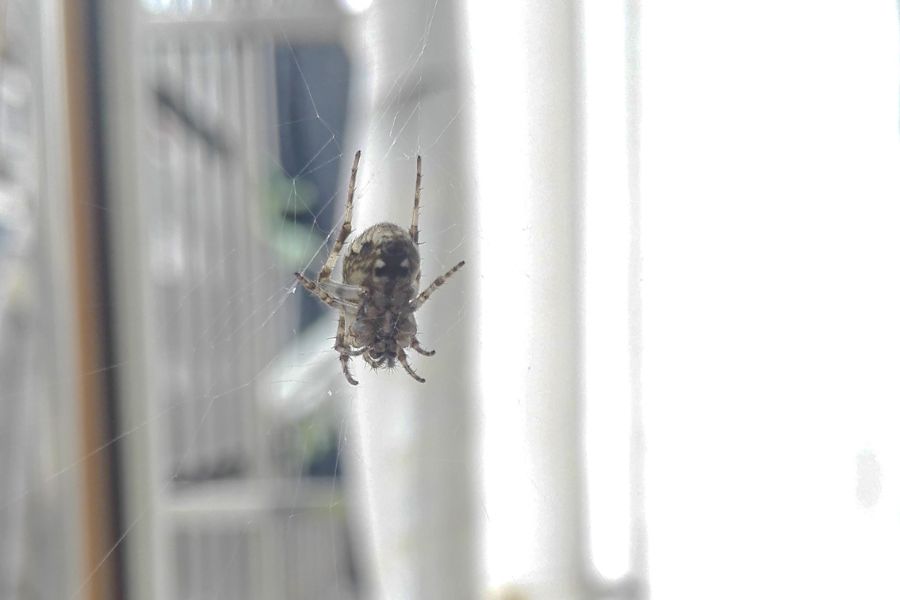
- Size: The Grey House Spider typically measures around 4 mm on average
- Where in Thailand they can be found: Grey House Spiders are commonly found in urban areas, particularly in and around houses, buildings, and gardens. Hence the name, House Spider.
- When are they most active? They are most active during the night when they emerge from their hiding spots to hunt for prey.
- Do they bite? Grey House Spiders possess venom, but their bites are generally not harmful and symptoms are usually mild, similar to a bee sting. They only bite when they are provoked.
- What to do if you encounter one: it is best to leave it undisturbed and avoid provoking it. They play a role in controlling insect populations.
The Grey House Spider, scientifically known as Zosis geniculata, is a common spider species found in Thailand.
These spiders have a compact body structure and greyish coloration with distinctive markings on their body and legs.
The grey coloration and intricate markings on the body of the Grey House Spider make it visually distinct among other spider species found in Thailand.
They are known for building their webs in corners, crevices, and other sheltered locations.
9. Heavy-Bodied Jumping Spider
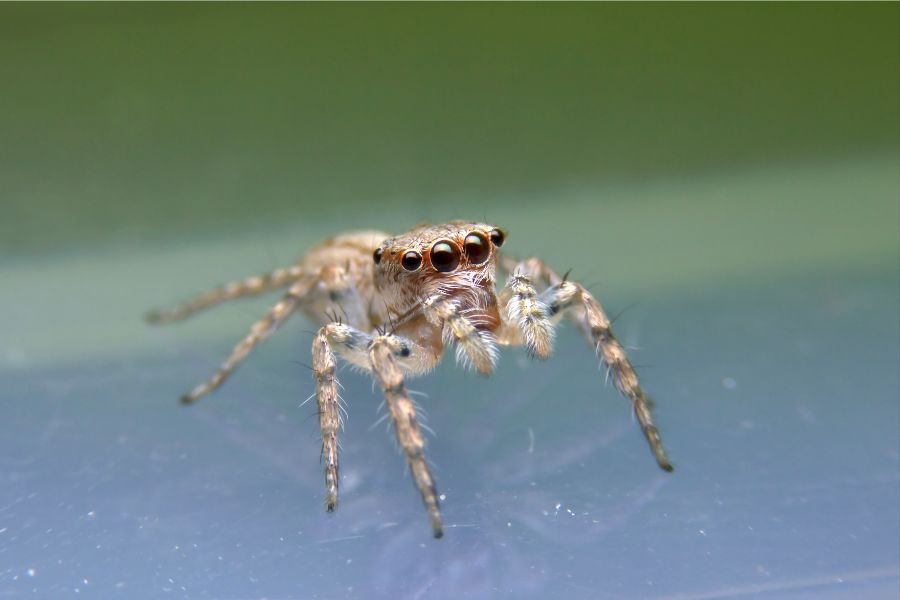
- Size: The average body length of the Heavy-Bodied Jumping Spider ranges from 7-9mm
- Where in Thailand they can be found: They are relatively common in Thailand and can be encountered throughout the country. They can be found in a variety of habitats, including forests, gardens, and vegetation-rich areas.
- When are they most active? They are most active during the warmer months when insect activity is high. They are diurnal creatures, which means they are active during the day.
- Do they bite? Like Grey House Spiders, Heavy-Bodied Jumping Spiders possess venom but their bites usually result in mild symptoms, similar to a bee sting.
- What to do if you encounter one: it is best to observe it from a safe distance without disturbing its habitat.
The Heavy-Bodied Jumping Spider is a small to medium-sized spider species found in Thailand.
These spiders have a stout and robust body shape, with relatively thick legs. They may come in various body shapes and are often camouflaged to blend with tree bark.
They are known for their excellent jumping ability, capable of leaping up to 20 times their body length. These spiders often hide on tree bark, waiting to ambush prey.
10. Huntsman Spider
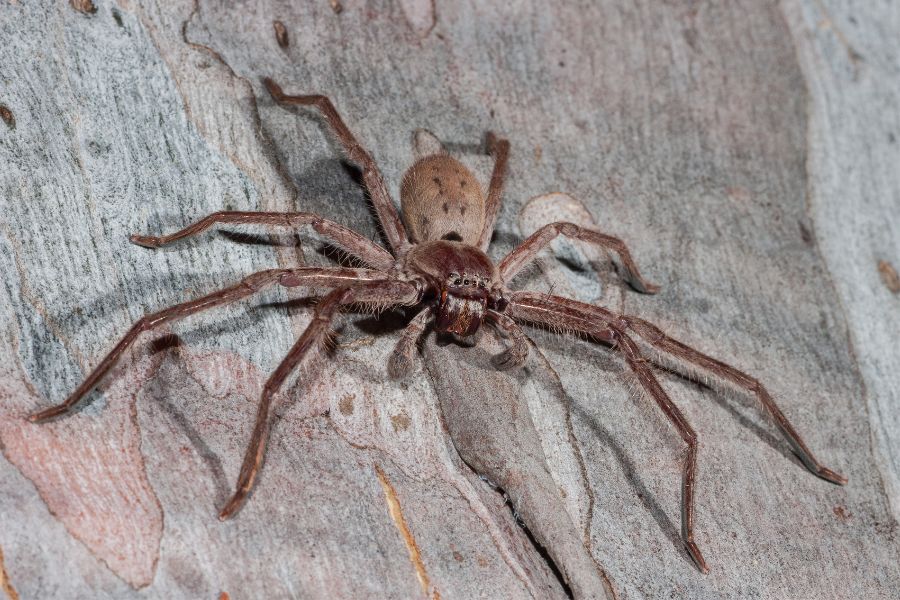
- Size: The leg span of a Huntsman Spider can reach up to 7-12 cm, while its body can measure up to 1 inch, making it one of the largest spiders in Thailand.
- Where in Thailand they can be found: They are commonly found in both urban and natural environments, such as houses, gardens, forests, and caves.
- When are they most active? They are most active during the night when they venture out in search of food. During the day, they typically hide in crevices or underneath objects.
- Do they bite? While they look scary, Huntsman Spiders are not harmful to humans. Bites are rare and usually result in mild symptoms, similar to a bee sting.
- What to do if you encounter one: if you encounter a Huntsman Spider, it is best to remain calm and avoid provoking or attempting to handle it. Gently guide it towards an exit with a broom if it is indoors.
The Huntsman Spider is the largest spider species found in Thailand, known for its impressive leg span.
Huntsman Spiders have a flattened body structure with long legs and come in various colors, including brown, gray, and sometimes with patterns.
They are known for their speed and agility, and can reach average speeds of 2.3 miles per hour. They are primarily nocturnal hunters and rely on their excellent eyesight to locate and capture prey.
They often come into buildings to shelter during the day.
In fact, we encountered one in our hotel room when we were staying in Ao Nang near Krabi.
We can confirm, they are incredibly fast and don’t like to be disturbed! We contacted the reception of our hotel and they helped us gently sweep it outside. No harm done to us or the spider.
11. Harvestman Spider
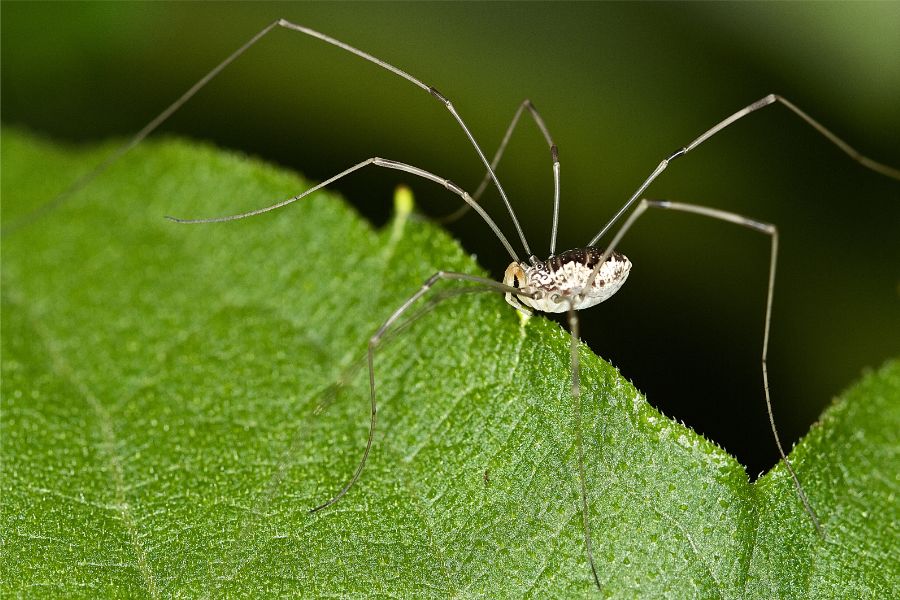
- Size: The Harvestman Spider has a compact body measuring around 0.6 – 23mm in length, with long and slender legs.
- Where in Thailand they can be found: These spiders are land and tree-dwellers, making their home in a wide range of environments all over Thailand, including forests, gardens, and urban areas.
- When are they most active? They are most active during the rainy season when insect activity is high. During drier months, they may seek shelter in crevices or beneath objects.
- Do they bite? Harvestman Spiders do not possess venom glands, and their bites are harmless to humans. They are considered non-aggressive and rarely bite if handled.
- What to do if you encounter one: As with all spiders, it’s best to avoid disturbing it to avoid agitating it. Appreciate it from a distance.
The Harvestman Spider, also known as the Daddy Longlegs Spider, is a common spider species found throughout Thailand.
Harvestman Spiders have a distinct appearance with their small body and extremely long, thin legs. They come in various colors, including brown and gray.
They play an essential role in the ecosystem as they feed on insects, mites, and small invertebrates. They are active during the rainy season when their food sources are abundant.
12. Jade Jumping Spider
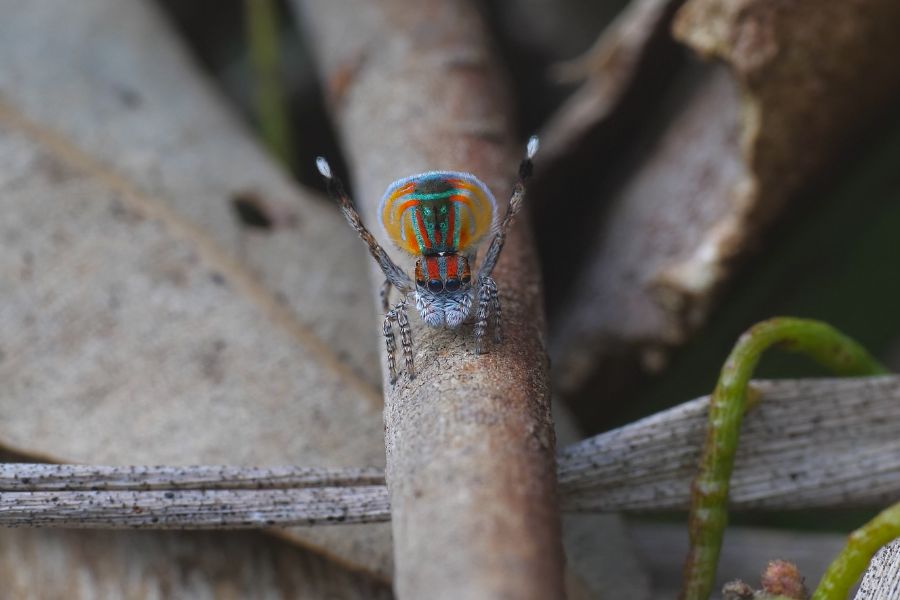
- Size: The Jade Jumping Spider is a tiny spider, with males measuring around 5-6 millimeters in length, while females are slightly larger at 6-7 millimeters
- Where in Thailand they can be found: Jade Jumping Spiders can be found in low foliage areas, such as forests, gardens, and vegetation-rich habitats in Thailand.
- When are they most active? Jade Jumping Spiders are most active during the day, particularly in the warmer months when insect activity is high.
- Do they bite? The bite of the Jade Jumping Spider is generally harmless to humans. They are non-aggressive and rarely bite unless provoked or threatened.
- What to do if you encounter one: It’s best to appreciate its unique green coloration and jumping abilities from a distance.
The Jade Jumping Spider, scientifically known as Siler semiglaucus, is a species of jumping spider found in Thailand.
It is characterized by its vibrant green coloration, which gives it the name “Jade” Jumping Spider. They have compact bodies and large eyes.
These spiders are agile hunters that rely on their excellent vision to locate and capture prey. They are known for their fearless nature and are not easily intimidated by larger creatures.
13. Kidney Garden Spider
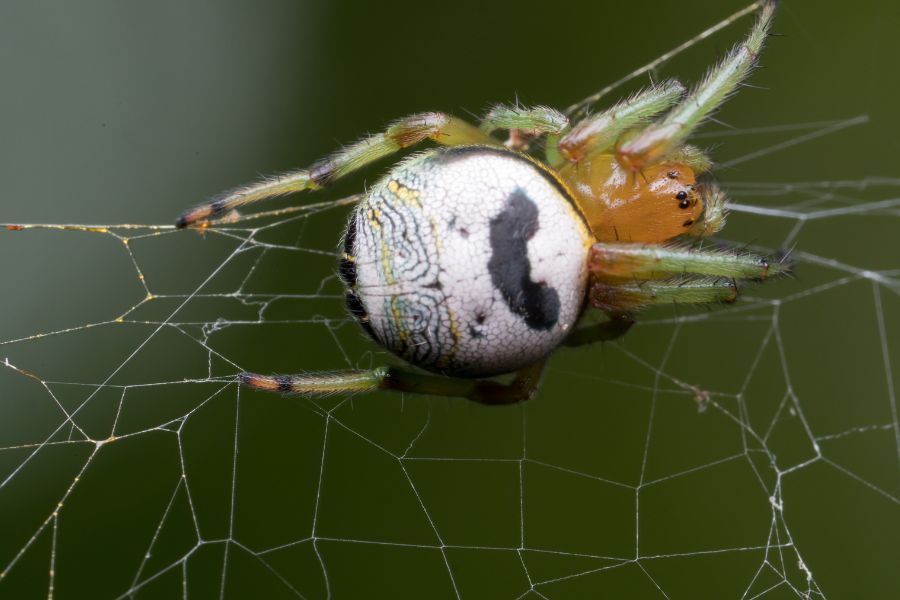
- Size: The Kidney Garden Spider measures around 6-9 mm in size on average
- Where in Thailand they can be found: They are commonly found in gardens, wayside vegetation, and tropical forests in Thailand.
- When are they most active? These spiders are typically active during warmer months when insect activity is high.
- Do they bite? While the venom of the Kidney Garden Spider is not considered dangerous to humans, it is always best to avoid provoking or handling them
- What to do if you encounter one: It is recommended to appreciate its unique markings and delicate web from a safe distance. Avoid disturbing its habitat.
The Kidney Garden Spider, scientifically known as Araneus mitificus, is a species of orb-weaver spider found in South, East, and Southeast Asia, including Thailand.
It has light green legs and a fat white abdomen with a distinct thick black U-shaped mark.
Kidney Garden Spiders build orb webs to catch their prey. They are not aggressive and generally retreat if disturbed.
14. Lawn Wolf Spider

- Size: The average size of the Lawn Wolf Spider is around 10-35mm.
- Where in Thailand they can be found: Lawn Wolf Spiders are found in Thailand’s grassy woodland areas, particularly in places like Pang Sida National Park and Huai Kha Khaeng Wildlife Sanctuary.
- When are they most active? Lawn Wolf Spiders are most active at night or when the sky is overcast.
- Do they bite? The Lawn Wolf Spider’s bite is venomous but it’s not toxic to humans, therefore they poses no danger to humans.
- What to do if you encounter one: It is best to avoid disturbing it and to watch it from a distance.
The Lawn Wolf Spider, scientifically known as Hippasa holmerae, is another common species of spider found in Thailand.
They are known for their unique faces, in which their eight eyes are arranged in three rows.
These spiders are known for living in shallow burrows and congregating in leafy and grassy environments. They are skilled at camouflage and are excellent hunters.
The Lawn Wolf Spider’s ability to camouflage and its presence in grassy woodland areas set it apart from other spider species found in Thailand.
15. Long-Horned Orbweavers
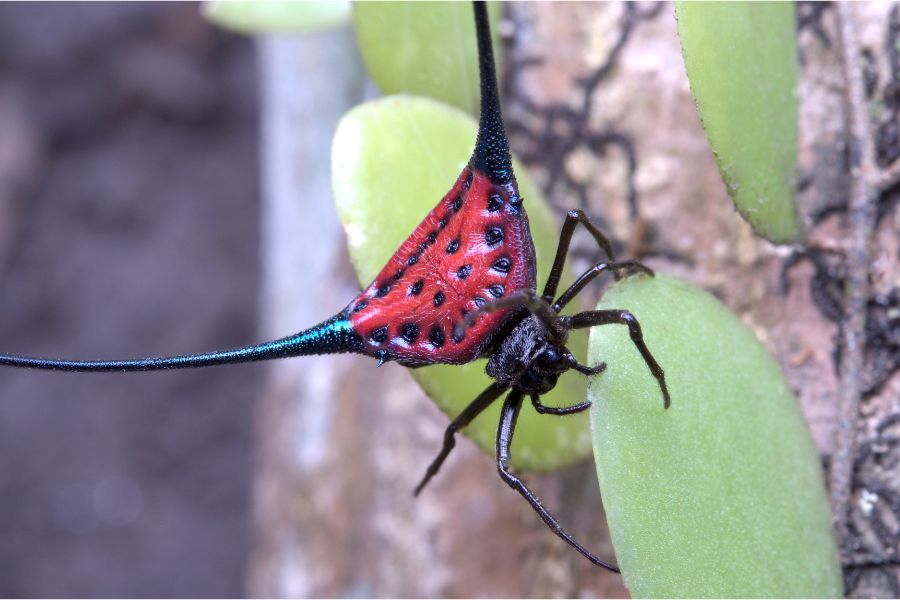
- Size: Long-Horned Orbweavers are usually between 8mm – 9mm on average
- Where in Thailand they can be found: Long-Horned Orbweavers are found in heavily forested areas, including tropical rainforests, in Thailand.
- When are they most active? They are usually active during the evening and shelter from the sun during the day.
- Do they bite? While the venom of the Long-Horned Orbweaver is not known to be dangerous to humans, it is always best to avoid provoking or handling them.
- What to do if you encounter one: If you encounter a Long-Horned Orbweaver, it is recommended to appreciate its unique appearance and observe it from a safe distance without disturbing its web or habitat.
The Long-Horned Orbweaver, scientifically known as Macracantha arcuata, is a species of spider found in Thailand known for its distinct appearance with elongated spines or “horns” protruding from its abdomen. It is typically red or yellow in color.
They weave intricate orb-shaped webs to catch their prey. These spiders are usually docile and non-aggressive.
The long spines or “horns” on its abdomen make the Long-Horned Orbweaver visually distinctive among spider species found in Thailand.
16. Two-Striped Telamonia
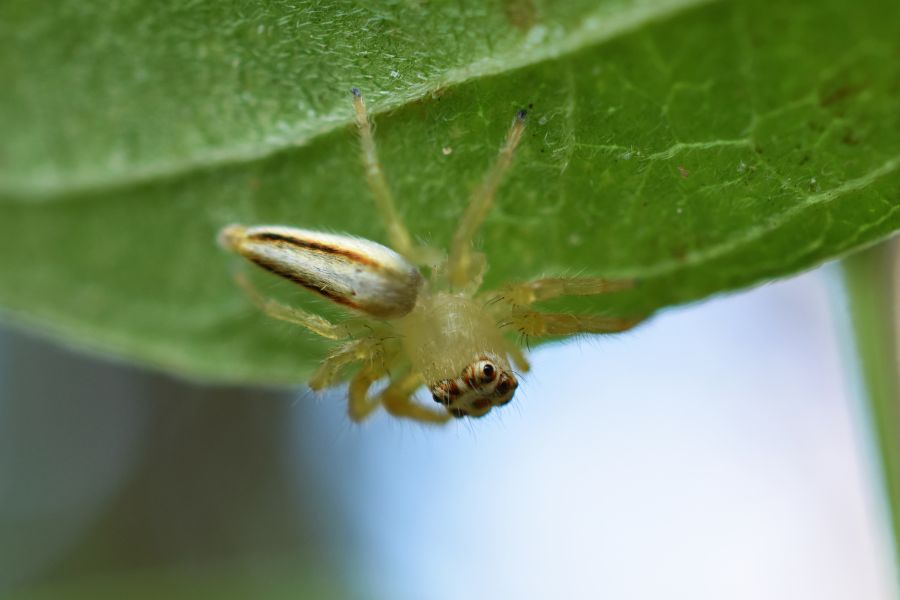
- Size: Female Two-Striped Telamonia typically measure from 9-11mm on average, and males range from 8mm-9mm.
- Where in Thailand they can be found: These spiders are found in grassland areas and parks in Thailand, including Chatuchak Park in Bangkok and Chiang Mai University.
- When are they most active?
- Do they bite? Yes, they do bite and their venom is extremely toxic and can take several days for the toxins to take effect. However, they usually don’t bite unless disturbed.
- What to do if you encounter one: If you encounter a Two-Striped Telamonia spider, it is recommended to observe it from a safe distance without disturbing its habitat. Appreciate its unique appearance and behavior.
The Two-Striped Telamonia, scientifically known as Telamonia dimidiata, is a jumping spider known for its distinctive orange stripes on both sides of its lower body.
Two-Striped Telamonia spiders are active hunters and are known for their jumping abilities. They primarily feed on insects and other small prey.
They are sometimes known to hide beneath toilet seats, so do make sure to check before you sit. This is one spider you don’t want to sit on!
17. Sheet Weaver

- Size: They are small spiders that are usually less than 1cm in length
- Where in Thailand they can be found: Sheet Weavers can be found in various habitats in Thailand, including grasslands and gardens.
- When are they most active? They tend to build their webs at night and wait for prey to fall into their traps in the day.
- Do they bite? They are not known to bite people and poses no danger to humans.
- What to do if you encounter one: If you encounter a Sheet Weaver spider, it is recommended to observe it from a safe distance without disturbing its web or habitat.
The Sheet Weaver, belonging to the family Linyphiidae, is characterized by its slim body structure and whitish-yellow color with stripes in yellow and black.
These spiders are known for the intricate sheet-like webs they create. They build their webs horizontally, often near the ground, to catch small prey.
What makes these spiders unique is that they typically live for less than one year, usually only for a few months. This means they are active all year round.
They are common amongst agricultural areas.
18. Yellow-Sac Spider

- Size: They are small spiders that typically grow to be 7-10mm long
- Where in Thailand they can be found: These spiders can be found in various habitats in Thailand, including grasslands, gardens, and homes.
- When are they most active? They are nocturnal and are most active at night.
- Do they bite? The Yellow-Sac Spider is known to deliver a bite that can cause sharp pain, which may last several days, as well as cause necrotic lesions. If bitten, seeking medical attention is advisable.
- What to do if you encounter one: If you encounter a Yellow-Sac Spider, it is recommended to avoid provoking or handling it. Give the spider its space and observe it from a safe distance.
The Yellow-Sac Spider, scientifically known as Cheiracanthium spp., is known for its pale-colored body, and its abdomen can be yellow or beige with a faint dark stripe running along it.
Yellow-Sac Spiders are known for building sac-like webs in vegetation or man-made structures. They are active hunters and can be frequently seen crawling on plants.
While they are venomous and their bites can be harmful, they don’t usually bite unless they feel threatened. Their bites are usually not life threatening.
FAQS About Spiders in Thailand
Are spiders poisonous in Thailand?
There are several species of poisonous spider in Thailand, including the Black Widow and Brown Widow, which are the most venomous.
Will I see spiders in Thailand?
Most tourists visiting Thailand won’t see spiders unless they go looking for them. However, spiders can sometimes find their ways into hotel rooms during the rainy season, so if you’re traveling to Thailand during this time, you may have a house guest waiting for you.
Does Thailand have tarantulas?
Yes, there are a few species of tarantula in Thailand. The most common ones are the Cobalt Blue, Thai Zebra tarantula, and the Thai Black tarantula. The most common tarantula is the Thai Black tarantula.
Final Thoughts On Spiders in Thailand
So there you have it, those are the most common types of spider in Thailand.
It might sound scary when you see a huge list like this, but remember, the chances of you encountering a spider are pretty slim.
Remember if you do see any of these spiders, it’s best to leave it alone and admire it from a distance.

There was a green and small spider that very thin and live in house?
Hi Aye, it could have been one of the spiders on this list, such as the Banded Phintella, Fighting Spider / Metallic Blue Jumping Spider or Jade Jumping Spider. Without a picture it would be hard to help you identify it.